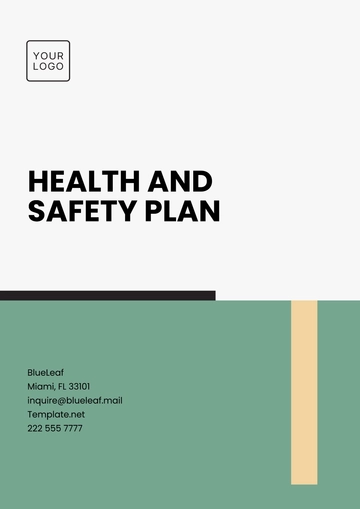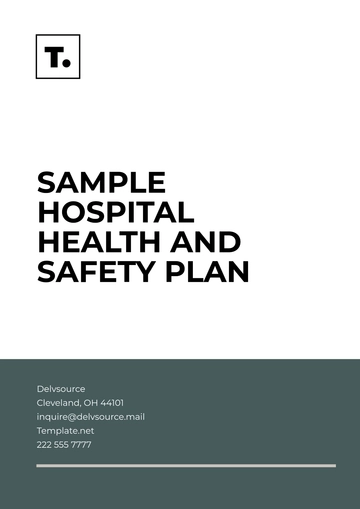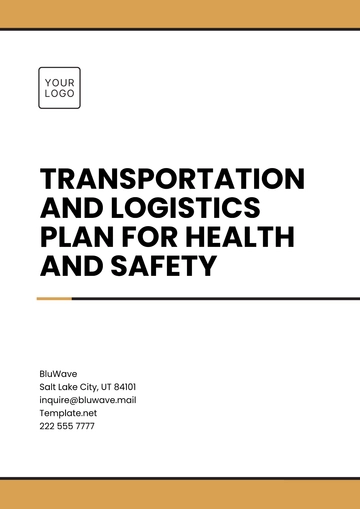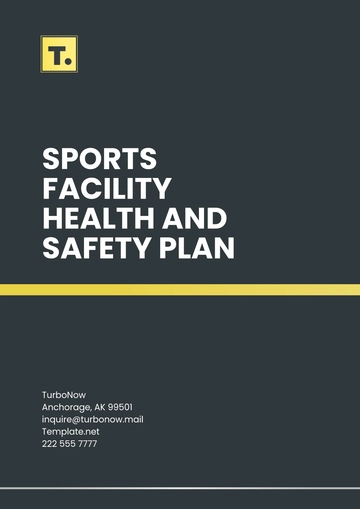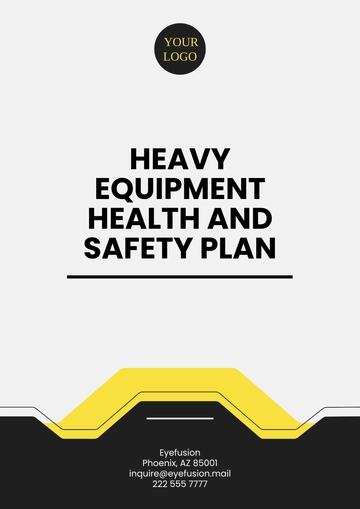Free Construction Site Safety Management Plan HR

Management Plan HR
INTRODUCTION
Welcome to [Your Company Name]
Welcome to [Your Company Name], where your safety and well-being are paramount. As we embark on construction projects, it's essential to ensure a work environment that prioritizes safety above all else. This Construction Site Safety Management Plan serves as your guide to understanding the measures we've put in place to keep you safe during our construction endeavors.
Our commitment to safety extends beyond mere compliance with regulations. We believe in fostering a culture of vigilance, responsibility, and care. Whether you're a seasoned construction professional or new to the industry, your active participation in our safety protocols is vital.
Purpose of the Safety Management Plan
The primary purpose of this Safety Management Plan is to establish a comprehensive framework for the management of safety on our construction sites. Its key objectives include:
Preventing Accidents: We aim to create a work environment where accidents and injuries are minimized, if not entirely prevented. By adhering to the guidelines within this plan, we seek to eliminate hazards and mitigate risks effectively.
Protecting Lives: The safety of our employees, subcontractors, visitors, and the general public is of utmost importance. This plan outlines procedures to ensure that everyone involved in our construction projects returns home safely every day.
Regulatory Compliance: We are committed to complying with all relevant local, state, and federal safety regulations. This plan serves as a roadmap for our compliance efforts, ensuring that we meet or exceed all applicable safety standards.
Cultivating a Safety Culture: Beyond regulatory requirements, we aspire to cultivate a culture of safety consciousness. This plan encourages active participation, open communication, and continuous improvement in safety practices.
SAFETY POLICY AND COMMITMENT
Safety Policy Statement
Our safety policy at [Your Company Name] is a declaration of our unwavering commitment to safety excellence. We firmly believe that every incident is preventable and that safety is the shared responsibility of every individual on our construction sites. Our safety policy can be summarized as follows:
[Your Company Name]'s Safety Policy:
Safety is Our Priority: The safety of our personnel, subcontractors, and the public is paramount in all our operations.
Compliance: We are fully committed to complying with all applicable safety laws and regulations.
Prevention: Our objective is to prevent accidents, incidents, and injuries through vigilant hazard identification, assessment, and control measures.
Training: We invest in comprehensive safety training and education to equip our team with the knowledge and skills necessary for safe practices.
Continuous Improvement: We continually review our safety performance, learn from incidents, and enhance our safety practices.
Responsibility: Safety is everyone's responsibility, and all employees and subcontractors are expected to actively participate in our safety program.
Senior Management's Commitment
Our senior management team is dedicated to providing the necessary leadership, resources, and support to ensure that our safety policy is effectively implemented. Their commitment includes:
Allocating Resources: Adequate resources, including personnel, training, and equipment, are provided to support safety initiatives.
Leadership: Senior management leads by example and actively participates in safety programs and activities.
Open Communication: A culture of open communication is fostered, allowing all team members to report safety concerns without fear of reprisal.
Accountability: Senior management is accountable for the overall safety performance of the organization, and safety goals are integrated into business objectives.
Continuous Improvement: A commitment to continuous improvement ensures that safety initiatives evolve to address emerging risks and challenges.
ROLES AND RESPONSIBILITIES
In our commitment to construction site safety, each team member has specific roles and responsibilities to ensure the effective implementation of safety measures. Here's a breakdown of these roles:
ROLE | RESPONSIBILITIES |
Project Manager | Oversee and lead the safety program on the construction site. |
Develop and communicate safety policies, objectives, and performance standards. | |
Ensure that safety requirements are integrated into project planning and execution. | |
Monitor safety performance, including incident reports and safety inspections. | |
Collaborate with the site supervisor and safety officer to address safety concerns. | |
Lead safety meetings and toolbox talks to promote awareness and adherence to safety protocols. | |
Site Supervisor | Supervise and manage daily construction activities with a focus on safety. |
Enforce safety policies and procedures, ensuring workers comply with safety rules | |
Conduct regular safety inspections and hazard assessments on the construction site. | |
Address and report safety concerns promptly to the project manager and safety officer. | |
Provide guidance and training to workers on safe work practices and proper use of PPE. | |
Safety Officer | Serves as the primary point of contact for safety-related matters on the construction site. |
Develop, implement, and maintain safety programs, policies, and procedures. | |
Conduct safety training and orientation for all workers and subcontractors. | |
Investigate and document incidents, accidents, and near misses, and recommend corrective actions. | |
Collaborate with the project manager and site supervisor to ensure a safe work environment. | |
Workers | Comply with all safety rules, regulations, and procedures on the construction site. |
Wear appropriate PPE as required for specific tasks and activities. | |
Report hazards, unsafe conditions, and incidents to their immediate supervisor. | |
Participate in safety training, toolbox talks, and emergency drills. | |
Support a culture of safety by actively contributing to safety discussions and initiatives. |
HAZARD IDENTIFICATION AND ASSESSMENT
Identifying Hazards
To maintain a safe construction environment, hazard identification is an ongoing process. All team members are responsible for identifying and reporting potential hazards, including but not limited to:
HAZARD TYPE | DESCRIPTION |
Physical Hazards | Such as uneven terrain, falling objects, and machinery. |
Chemical Hazards | Including exposure to hazardous substances and materials. |
Biological Hazards | Such as exposure to pathogens or insect vectors. |
Ergonomic Hazards | Related to repetitive tasks or improper ergonomics. |
Psychosocial Hazards | Such as stress, fatigue, or harassment. |
Risk Assessment
Upon identifying hazards, a risk assessment will be conducted to evaluate the level of risk associated with each hazard. Risk assessments consider factors such as the severity of potential harm, the likelihood of occurrence, and the number of people exposed. Risk levels are categorized as:
RISK LEVEL | DESCRIPTION |
Low Risk | Hazards that are unlikely to cause significant harm. |
Moderate Risk | Hazards that may cause harm but are manageable with control measures. |
High Risk | Hazards that pose a significant risk of severe harm and require immediate attention and mitigation. |
Hazard Control Measures
Control measures will be implemented based on the outcome of the risk assessment. These measures may include:
Elimination: Completely removing the hazard from the work environment.
Substitution: Replacing a hazardous substance, material, or process with a safer alternative.
Engineering Controls: Implementing physical changes to reduce or mitigate the hazard.
Administrative Controls: Establishing policies, procedures, and training to manage the hazard.
Personal Protective Equipment (PPE): Providing and mandating the use of appropriate PPE when other control measures are not feasible.
SAFE WORK PRACTICES
General Safety Rules
Equipment Operation
Ensure that only trained and authorized personnel operate heavy machinery and equipment.
Conduct pre-operational checks of machinery to identify any defects or malfunctions before use.
Follow the manufacturer's guidelines for equipment use, including load limits and safe operating speeds.
Fall Protection
Use appropriate fall protection measures, such as guardrails, safety nets, or personal fall arrest systems, when working at heights exceeding [X feet].
Inspect fall protection equipment regularly and replace any damaged or worn components.
Scaffolding Safety
Inspect scaffolding before use and ensure it is erected, dismantled, and maintained by competent personnel.
Adhere to weight limits and do not overload scaffolds.
Use guardrails and fall protection equipment when working on scaffolding at elevated heights.
Ladder Safety
Position ladders on stable, level surfaces and secure them to prevent slipping or tipping.
Maintain three points of contact while ascending or descending ladders.
Do not use ladders as work platforms unless designed for that purpose.
Personal Protective Equipment (PPE)
Head Protection
Wear approved hard hats in designated areas where falling objects pose a risk.
Replace hard hats that show signs of damage or wear.
Eye and Face Protection
Use appropriate eye and face protection, such as safety glasses, goggles, or face shields, when exposed to potential eye hazards.
Clean and maintain eye protection to ensure clear vision.
Hearing Protection
Wear hearing protection, such as earplugs or earmuffs, when working in areas with high noise levels.
Participate in regular hearing protection fit-testing and audiometric testing.
Respiratory Protection
Use respiratory protection, such as dust masks or respirators, in areas with airborne contaminants.
Properly store, clean, and maintain respiratory protection equipment.
Hand Protection
Wear appropriate gloves when handling materials or performing tasks that may cause hand injuries.
Choose gloves suitable for the specific hazards present, such as chemical-resistant gloves for handling hazardous substances.
Emergency Response Procedures
Fire Safety
Know the locations of fire extinguishers, fire alarms, and emergency exits.
In case of fire, raise the alarm, evacuate immediately, and use fire extinguishers if safe to do so.
Follow designated evacuation routes and assembly points.
Medical Emergencies
Familiarize yourself with the location of first aid kits and automated external defibrillators (AEDs).
In case of a medical emergency, provide first aid assistance as trained and call emergency services.
SAFETY INSPECTIONS AND AUDITS
Regular Site Inspections
Regular site inspections are a cornerstone of our commitment to safety. These inspections are conducted to proactively identify potential hazards, unsafe practices, and areas that require attention. Here's how the process works:
Frequency: Site inspections will be conducted on a regular basis, with a minimum frequency of every 3 weeks.
Inspection Team: Trained safety officers or designated personnel will carry out the inspections. They will be equipped with checklists to ensure a comprehensive evaluation.
Scope: The inspections cover all aspects of the construction site, including but not limited to work areas, machinery, tools, equipment, storage areas, access points, and common areas.
Hazard Identification: Inspectors will actively identify hazards such as unguarded machinery, exposed electrical wiring, improper storage of materials, and inadequate signage.
Documentation: Detailed reports of the inspections will be generated, noting findings, identified hazards, and recommended corrective actions.
Corrective Actions: Identified hazards will be promptly addressed by implementing corrective actions. The responsible parties will ensure that these actions are completed within specified timeframes.
Communication: Inspection findings will be communicated to site supervisors, workers, and relevant parties. Any urgent or critical issues will be communicated immediately for immediate attention.
Follow-Up: Regular inspections will be followed by subsequent checks to ensure that corrective actions have been effective and that the site remains in compliance with safety standards.
External Safety Audits
External safety audits serve as an additional layer of assurance that our construction sites adhere to safety regulations and industry best practices. These audits are conducted by independent safety professionals or regulatory authorities. Here's how they are carried out:
Frequency: External safety audits will be conducted periodically, as required by local regulations and company policies.
Audit Team: Independent safety auditors, qualified to assess construction safety standards, will conduct the audits.
Scope: Audits cover all aspects of site safety, evaluating compliance with local regulations, industry standards, and our internal safety policies.
Documentation Review: Auditors will review safety documentation, including inspection reports, incident records, safety training records, and permits to work.
On-Site Assessment: Auditors will visit the construction site to observe ongoing work, safety practices, and the implementation of safety control measures.
Interviews: Interviews with site personnel, including workers, supervisors, and safety officers, may be conducted to gather insights into safety practices and awareness.
Findings and Recommendations: Auditors will compile findings and provide recommendations for improving safety practices, complying with regulations, and enhancing overall safety performance.
Corrective Actions: Based on audit findings, corrective actions will be developed and implemented in collaboration with site management. Timelines for action completion will be established.
Follow-Up: Auditors may conduct follow-up audits to ensure that corrective actions have been effectively implemented and that the site remains in compliance.
EMERGENCY PREPAREDNESS
Emergency Response Plan
Our emergency response plan is a comprehensive strategy designed to address a wide range of potential emergencies that may occur on our construction sites. It outlines the steps to take in the event of an emergency and is essential for safeguarding the well-being of all personnel. Here are the key elements of our plan:
Emergency Types: Our plan covers various types of emergencies, including fires, natural disasters, hazardous material spills, medical emergencies, and more.
Evacuation Procedures: Clear and well-marked evacuation routes and assembly points are established at every construction site. Workers are trained on evacuation procedures and the location of assembly points.
Emergency Contacts: Contact information for emergency services, medical facilities, and internal emergency response teams is readily available and communicated to all site personnel.
First Aid Stations: First aid stations equipped with necessary supplies are strategically located on-site. Qualified personnel trained in first aid are designated to provide immediate assistance when required.
Communication Protocols: Effective communication during emergencies is crucial. Our plan outlines communication procedures, including how to alert personnel, emergency services, and relevant authorities.
Emergency Equipment: We maintain emergency equipment such as fire extinguishers, first aid kits, AEDs (Automated External Defibrillators), and other essential tools to respond to specific emergency situations.
Training and Drills: Regular emergency drills and training exercises are conducted to ensure that all personnel are familiar with emergency procedures and can respond effectively in high-stress situations.
SAFETY RECORDS AND DOCUMENTATION
Record Keeping
Accurate record-keeping is essential for tracking and maintaining safety-related information. At [Your Company Name], we maintain the following safety records:
Incident Reports: All incidents, accidents, near misses, and related investigations are documented in detail. These reports include information about the incident, root cause analysis, corrective actions taken, and preventive measures implemented.
Inspection Logs: Regular safety inspections are conducted, and the findings are recorded in inspection logs. These logs document the date of inspection, the areas inspected, identified hazards, and actions taken to address them.
Training Records: Records of safety training and certifications for all employees, including subcontractors, are maintained. This documentation ensures that all personnel are adequately trained and up to date with safety procedures.
Documentation Retention
To comply with legal requirements and for reference purposes, we adhere to the following documentation retention practices:
Retention Periods: Safety records are retained for a minimum of 7 years after project completion. This period may vary depending on the nature of the records and legal requirements.
Secure Storage: All safety records are securely stored in a designated area, ensuring their confidentiality and protection from damage or loss.
Accessibility: Records are accessible to authorized personnel, safety auditors, and regulatory authorities for review and auditing purposes.
LEGAL AND REGULATORY COMPLIANCE
OSHA and Regulatory Requirements
[Your Company Name] is committed to full compliance with all relevant federal, state, and local safety regulations, including those set forth by the Occupational Safety and Health Administration (OSHA) and other regulatory bodies. To ensure compliance, we:
Regularly Monitor Regulations: We keep abreast of changes and updates to safety regulations, ensuring that our safety policies and procedures align with current standards.
Employee Training: Our employees, including management and safety personnel, undergo regular training to stay informed about regulatory requirements and changes.
Auditing and Inspections: We conduct periodic safety audits and inspections to verify compliance with OSHA and other regulations. Any discrepancies or non-compliance issues are addressed immediately.
Permits and Licenses
We recognize the importance of obtaining the necessary permits and licenses for construction activities, and we ensure compliance by:
Identification: Prior to commencing any construction project, we identify and obtain all required permits and licenses. This includes permits related to site operations, environmental impact assessments, and other specific project needs.
Monitoring Expiry Dates: We closely monitor the expiration dates of permits and licenses and renew them as required to maintain continuous compliance throughout the project.
Reporting and Documentation: Copies of permits and licenses are kept on-site and readily accessible for review by regulatory authorities. Documentation includes details of permits, their status, and contact information for the issuing agencies.
CONCLUSION
Commitment to Safety Excellence
By adhering to this Construction Site Safety Management Plan, we demonstrate our unwavering commitment to safety excellence, protecting lives, and ensuring the success of our construction projects.
- 100% Customizable, free editor
- Access 1 Million+ Templates, photo’s & graphics
- Download or share as a template
- Click and replace photos, graphics, text, backgrounds
- Resize, crop, AI write & more
- Access advanced editor
Discover the ultimate solution for construction site safety with Template.net's Construction Site Safety Management Plan HR Template. Crafted for efficiency, this editable and customizable template empowers you to tailor safety protocols effortlessly. With our intuitive AI Editor Tool, ensure seamless integration of policies and procedures, fostering a culture of safety on-site. Build confidently with Template.net.
You may also like
- Finance Plan
- Construction Plan
- Sales Plan
- Development Plan
- Career Plan
- Budget Plan
- HR Plan
- Education Plan
- Transition Plan
- Work Plan
- Training Plan
- Communication Plan
- Operation Plan
- Health And Safety Plan
- Strategy Plan
- Professional Development Plan
- Advertising Plan
- Risk Management Plan
- Restaurant Plan
- School Plan
- Nursing Home Patient Care Plan
- Nursing Care Plan
- Plan Event
- Startup Plan
- Social Media Plan
- Staffing Plan
- Annual Plan
- Content Plan
- Payment Plan
- Implementation Plan
- Hotel Plan
- Workout Plan
- Accounting Plan
- Campaign Plan
- Essay Plan
- 30 60 90 Day Plan
- Research Plan
- Recruitment Plan
- 90 Day Plan
- Quarterly Plan
- Emergency Plan
- 5 Year Plan
- Gym Plan
- Personal Plan
- IT and Software Plan
- Treatment Plan
- Real Estate Plan
- Law Firm Plan
- Healthcare Plan
- Improvement Plan
- Media Plan
- 5 Year Business Plan
- Learning Plan
- Marketing Campaign Plan
- Travel Agency Plan
- Cleaning Services Plan
- Interior Design Plan
- Performance Plan
- PR Plan
- Birth Plan
- Life Plan
- SEO Plan
- Disaster Recovery Plan
- Continuity Plan
- Launch Plan
- Legal Plan
- Behavior Plan
- Performance Improvement Plan
- Salon Plan
- Security Plan
- Security Management Plan
- Employee Development Plan
- Quality Plan
- Service Improvement Plan
- Growth Plan
- Incident Response Plan
- Basketball Plan
- Emergency Action Plan
- Product Launch Plan
- Spa Plan
- Employee Training Plan
- Data Analysis Plan
- Employee Action Plan
- Territory Plan
- Audit Plan
- Classroom Plan
- Activity Plan
- Parenting Plan
- Care Plan
- Project Execution Plan
- Exercise Plan
- Internship Plan
- Software Development Plan
- Continuous Improvement Plan
- Leave Plan
- 90 Day Sales Plan
- Advertising Agency Plan
- Employee Transition Plan
- Smart Action Plan
- Workplace Safety Plan
- Behavior Change Plan
- Contingency Plan
- Continuity of Operations Plan
- Health Plan
- Quality Control Plan
- Self Plan
- Sports Development Plan
- Change Management Plan
- Ecommerce Plan
- Personal Financial Plan
- Process Improvement Plan
- 30-60-90 Day Sales Plan
- Crisis Management Plan
- Engagement Plan
- Execution Plan
- Pandemic Plan
- Quality Assurance Plan
- Service Continuity Plan
- Agile Project Plan
- Fundraising Plan
- Job Transition Plan
- Asset Maintenance Plan
- Maintenance Plan
- Software Test Plan
- Staff Training and Development Plan
- 3 Year Plan
- Brand Activation Plan
- Release Plan
- Resource Plan
- Risk Mitigation Plan
- Teacher Plan
- 30 60 90 Day Plan for New Manager
- Food Safety Plan
- Food Truck Plan
- Hiring Plan
- Quality Management Plan
- Wellness Plan
- Behavior Intervention Plan
- Bonus Plan
- Investment Plan
- Maternity Leave Plan
- Pandemic Response Plan
- Succession Planning
- Coaching Plan
- Configuration Management Plan
- Remote Work Plan
- Self Care Plan
- Teaching Plan
- 100-Day Plan
- HACCP Plan
- Student Plan
- Sustainability Plan
- 30 60 90 Day Plan for Interview
- Access Plan
- Site Specific Safety Plan
